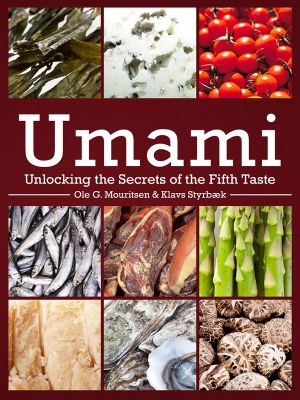Umami

- Authors
- Mouritsen, Ole G.
- Publisher
- Columbia University Press
- Tags
- technology & engineering , food science , spices , cooking , specific ingredients , herbs , condiments , tec012000 , ckb040000
- ISBN
- 9780231537582
- Date
- 2014-06-03T00:00:00+00:00
- Size
- 46.76 MB
- Lang
- en
In the West, we have identified only four basic tastessour, sweet, salty, and bitterthat, through skillful combination and technique, create delicious foods. Yet in many parts of East Asia over the past century, an additional flavor has entered the culinary lexicon: umami, a fifth taste impression that is savory, complex, and wholly distinct. Combining culinary history with recent research into the chemistry, preparation, nutrition, and culture of food, Mouritsen and Styrbk encapsulate what we know to date about the concept of umami, from ancient times to today. Umami can be found in soup stocks, meat dishes, air-dried ham, shellfish, aged cheeses, mushrooms, and ripe tomatoes, and it can enhance other taste substances to produce a transformative gustatory experience. Researchers have also discovered which substances in foodstuffs bring out umami, a breakthrough that allows any casual cook to prepare delicious and more nutritious meals with less fat, salt,...
In the West, we have identified only four basic tastes—sour, sweet, salty, and bitter—that, through skillful combination and technique, create delicious foods. Yet in many parts of East Asia over the past century, an additional flavor has entered the culinary lexicon: umami, a fifth taste impression that is savory, complex, and wholly distinct. Combining culinary history with recent research into the chemistry, preparation, nutrition, and culture of food, Mouritsen and Styrbæk encapsulate what we know to date about the concept of umami, from ancient times to today. Umami can be found in soup stocks, meat dishes, air-dried ham, shellfish, aged cheeses, mushrooms, and ripe tomatoes, and it can enhance other taste substances to produce a transformative gustatory experience. Researchers have also discovered which substances in foodstuffs bring out umami, a breakthrough that allows any casual cook to prepare delicious and more nutritious meals with less fat, salt, and sugar. The implications of harnessing umami are both sensuous and social, enabling us to become more intimate with the subtleties of human taste while making better food choices for ourselves and our families. This volume, the product of an ongoing collaboration between a chef and a scientist, won the Danish national Mad+Medier-Prisen (Food and Media Award) in the category of academic food communication.
In the West, we have identified only four basic tastes--sour, sweet, salty, and bitter--that, through skillful combination and technique, create delicious foods. Yet in many parts of East Asia over the past century, an additional flavor has entered the culinary lexicon: umami, a fifth taste impression that is savory, complex, and wholly distinct.
Combining culinary history with recent research into the chemistry, preparation, nutrition, and culture of food, Mouritsen and Styrb�k encapsulate what we know to date about the concept of umami, from ancient times to today. Umami can be found in soup stocks, meat dishes, air-dried ham, shellfish, aged cheeses, mushrooms, and ripe tomatoes, and it can enhance other taste substances to produce a transformative gustatory experience. Researchers have also discovered which substances in foodstuffs bring out umami, a breakthrough that allows any casual cook to prepare delicious and more nutritious meals with less fat, salt, and sugar. The implications of harnessing umami are both sensuous and social, enabling us to become more intimate with the subtleties of human taste while making better food choices for ourselves and our families.
This volume, the product of an ongoing collaboration between a chef and a scientist, won the Danish national Mad+Medier-Prisen (Food and Media Award) in the category of academic food communication.--Sandra J. Ackerman "American Scientist"